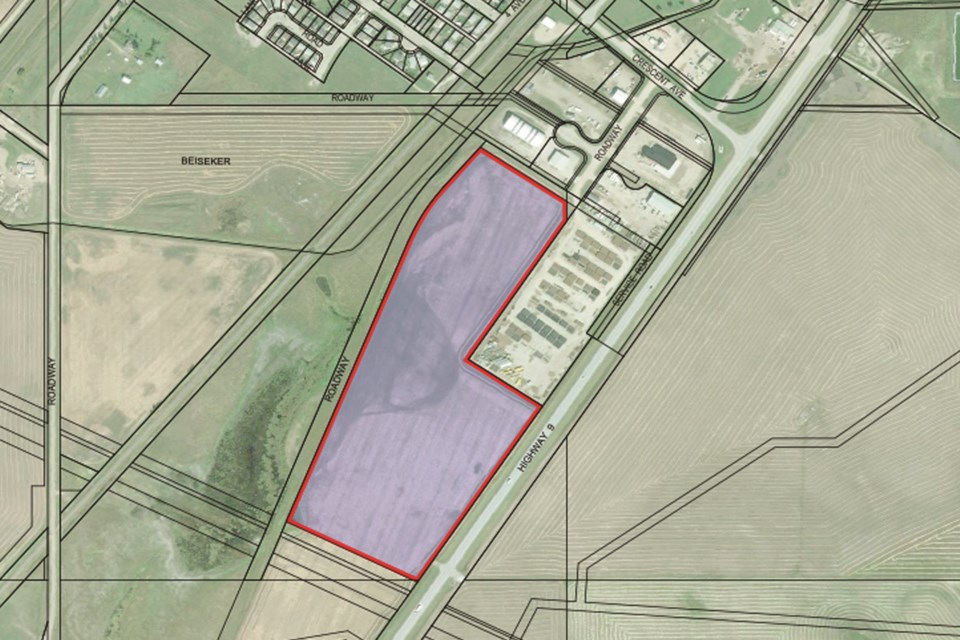Village of Beiseker council postponed a decision on a controversial biomedical waste incinerator that drew opposition from residents of Beiseker, Irricana and the surrounding area.
According to Mayor Warren Wise, council voted unanimously at a public hearing Oct. 15 to table the application by G-M Pearson until its Nov. 12 meeting in order to gather additional information from Alberta Health Services (AHS) and Alberta Environment and Parks.
“On receiving some of that information…we should be able to come up with a decision,” Wise said.
According to its website for the project, G-M Pearson proposes to build a thermal treatment plant in the Village’s southeast corner along Highway 9. If constructed, the facility would employ 22 people and dispose of approximately 8,000 tonnes of biomedical and other non-hazardous waste per year.
However, a petition with around 144 signatures was submitted to the Village at the time of the public hearing, according to Carla Perry, a concerned resident of Beiseker, and more signatures are expected to be collected as the process continues.
“Although this is obviously in Beiseker, the communities affected are not just Beiseker,” said Jennifer Ladrillo Green, a resident of Irricana. “It’s all the farms and acreages around in Rocky View County [and] Irricana.”
Primary complaints, according to Ladrillo Green, surround potential health effects on residents, livestock and crops due to dioxins and furans. According to a 2005 Health Canada document, “dioxins and furans are common names for toxic chemicals that are found in very small amounts in the environment, including air, water and soil.” Exposer to dioxin and furans has a wide range of adverse effects in laboratory animals and humans, the document said, including skin disorders, liver problems and certain types of cancer.
A tolerable level of dioxins, according to Health Canada, is 2.3 picograms per kilogram of body weight per day. A pictogram is one-trillionth of a gram.
“All these toxins bioaccumulate in your fat, in your body tissue,” Ladrillo Green said. “Maybe day one, day two, it’s not so bad, but what happens if you’re a resident living here?”
She added her concerns were not put to rest by attending an information session held by G-M Pearson.
“They could not speak intelligibly about the real health concerns that we had and that we asked,” she said.
Mike Fournier, project manager with G-M Pearson, said the stated purpose of the information sessions was to introduce people to the project and the process, and future information sessions would address those questions. He noted the project’s early stages relate to municipal issues, and health and environmental impacts are dealt with later at the provincial level.
“I think they’re valid questions, they’re valid concerns, and I think the process that is in place to get the permit from Alberta Environments and Parks [and] Alberta Health is set up to address those concerns, not just on a general level but specific to that site,” he said.
Fournier added he was confident in the process as a “credible, scientific process” to address health and environmental impacts.
Ladrillo Green said the timeline of the proposal initially felt rushed by council, and some residents felt it was being pushed through without public input. Concerned residents have since been reassured Village council is doing its due diligence, she said. Wise maintained council was not rushing the bylaw.
“We’re following procedure as we should,” he said.
Wise said the proposed facility would be a source of industry, tax revenue and jobs for Beiseker, but council will consider the apprehensions expressed by residents.
“The concerns of the people are very well justified,” he said. “What we have to do as a council is make a decision as to which offsets which.”
Around 130 are estimated to have attended the public hearing, Wise said, of those, most were opposed to the project. Ladrillo Green described the meeting as “intense,” and added she hopes council’s decision to table the application for the time being indicates resident concerns are being taken seriously.
Fournier said with degree of concerns expressed at the meeting, it was “absolutely appropriate” for council to table the decision, but he maintained many of the concerns would be addressed if the project progresses.
“You’ve got this situation where people are really trying to jump ahead and get the council to address concerns that are really within the jurisdiction of the province,” he said. “It’s kind of a horse and cart type of situation. Putting ourselves in their shoes, we absolutely understand why people go there, but at the same time, we don’t have a good answer.”
Coun. Nikki King, who had abstained from first reading during a Sept. 9 meeting because, according to the mayor, she was told by G-M Pearson’s lawyer, as an adjacent landowner, she was unable to vote on the bylaw going forward, under the MGA. Wise said King recused herself and did not vote on the tabling motion.
While Ladrillo Green said this frustrated some residents, Fournier said G-M Pearson was concerned about a possible conflict of interest.
“They have to make that determination. We don’t make the determination,” he said.
“It’s inaccurate to say we’re trying to block that person’s ability to vote.”
Wise said the Village’s understanding is that King may not vote on the matter in the future, but he added the Village “is looking into that.”



